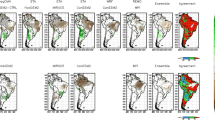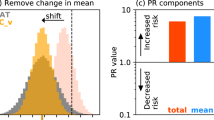Abstract
The impact of increasing atmospheric CO2 on high and low extremes of monthly-to-annual precipitation is studied using 20 model experiments participating in the second phase of the coupled model intercomparison project (CMIP2). In marked contrast with previous research on daily precipitation extremes, the simulated changes in extremes on these longer time scales are well correlated with the changes in the long-term mean precipitation: wet extremes become more severe especially where the mean precipitation increases, and dry extremes where the mean precipitation decreases. Changes in relative variability play a smaller but discernible role. In an ensemble-mean sense, the variability increases slightly in most areas, so that the contrast between the high and low precipitation extremes grows larger with increasing CO2. The changes in the frequency of extremes (fraction of cases with precipitation above a high or below a low predefined threshold) are much larger than the changes in their magnitude. Most of the ensemble-averaged changes in the frequency of extremes can be reconstructed by using the changes in time mean precipitation alone, provided that the variation in time mean precipitation change between different models is taken into account. The nonlinear relationship between the mean precipitation and the frequency of extremes complicates the interpretation of the frequency changes, especially when averaging frequencies over different models.








Similar content being viewed by others
References
Allen MR, Ingram WJ (2002) Constraints on future changes of climate and the hydrologic cycle. Nature 419: 224–231
Barthelet P, Terray L, Valcke S (1998) Transient CO2 experiment using the ARPEGE/OPAICE non flux corrected coupled model. Geophys Res Lett 25: 2277–2280
Boville BA, Gent PR (1998) The NCAR climate system model, version one. J Climate 11: 1115–1130
Braconnot P, Marti O, Joussaume S (1997) Adjustment and feedbacks in a global coupled ocean-atmosphere model. Clim Dyn 13: 507–519
Christensen JH, Christensen OB (2003) Severe summertime flooding in Europe. Nature 421: 805–806
Cubasch U, Meehl GA, Boer GJ, Stouffer RJ, Dix M, Noda A, Senior CA, Raper S, Yap KS (2001) Projections of future climate change. In: Houghton JT et al (eds) Climate change 2001. Cambridge University Press, Cambridge, pp 525–582
Diansky NA, Volodin EM (2002) Simulation of present-day climate with a coupled atmosphere-ocean general circulation model. Izvestia, Atmos Oceanic Phys 38: 732–747
Emori S, Nozawa T, Abe-Ouchi A, Numaguti A, Kimoto M, Nakajima T (1999) Coupled ocean-atmosphere model experiments of future climate change with an explicit representation of sulfate aerosol scattering. J Meteorol Soc Jpn 77: 1299–1307
Flato GM, Boer GJ, Lee WG, McFarlane NA, Ramsden D, Reader MC, Weaver AJ (2000) The Canadian Centre for Climate Modelling and Analysis global coupled model and its climate. Clim Dyn 16: 451–467
Giorgi F, Hewitson B, Christensen J, Hulme M, von Storch H, Whetton P, Jones R, Mearns L, Fu C (2001) Regional climate information—evaluation and projections. In: Houghton JT et al (eds) Climate change 2001. Cambridge University Press, Cambridge, UK, pp 583–638.
Gordon C, Cooper C, Senior CA, Banks H, Gregory JM, Johns TC, Mitchell JFB, Wood RA (2000) The simulation of SST, sea ice extents and ocean heat transports in a version of the Hadley Centre coupled model without flux adjustments. Clim Dyn 16: 147–166
Gregory JM, Mitchell JFB, Brady AJ (1997) Summer drought in northern midlatitudes in a time-dependent CO2 climate experiment. J Clim 10: 662–686
Groisman PYa, Karl TR, Easterling DR, Knight RW, Jamason PF, Hennessy KJ, Suppiah R, Page CM, Wibig J, Fortuniak K, Razuvaev VN, Douglas A, Førland E, Zhai P-M (1999) Changes in the probability of heavy precipitation: important indicators of climatic change. Clim Change 42: 243–283
Hegerl GC, Zwiers FW, Stott PA, Kharin VV (2004) Detectability of anthropogenic changes in annual temperature and precipitation extremes. J Clim 17: 3683–3700
Hirst A, O’Farrell SP, Gordon HP (2000) Comparison of a coupled ocean-atmosphere model with and without oceanic eddy-induced advection. Part I: ocean spinup and control integrations. J Clim 13: 139–163
Huntingford C, Jones RG, Prudhomme C, Lamb R, Gash JHC, Jones DA (2003) Regional climate-model predictions of extreme rainfall for a changing climate. Q J Roy Meteorol Soc 129: 607–1621
Johns TC, Carnell RE, Crossley JF, Gregory JM, Mitchell JFB, Senior CA, Tett SFB, Wood RA (1997) The second Hadley Centre coupled ocean-atmosphere GCM: model description, spinup and validation. Clim Dyn 13: 103–134
Katz RW, Brown BG (1992) Extreme events in a changing climate: variability is more important than averages. Clim Change 21: 303–315
Knutson TR, Delworth TL, Dixon KW, Stouffer RJ (1999) Model assessment of regional surface temperature trends (1949–1997) J Geophys Res 104: 30981–30996
Manabe S, Wetherald RT (1980) On the distribution of climate change resulting from an increase in CO2 content in the atmosphere. J Atm Sci 37: 99–118
Manabe S, Stouffer RJ, Spelman MJ, Bryan K (1991) Transient responses of a coupled ocean-atmosphere model to gradual changes of atmospheric CO2. Part I: annual mean response. J Clim 4: 785–818
Meehl GA, Zwiers F, Evans J, Knutson T, Mearns L, Whetton P (2000a) Trends in extreme weather and climate events: issues related to modelling extremes in projections of furure climate change. Bull Am Meteorol Soc 81: 427–436
Meehl GA, Boer GJ, Covey C, Latif M, Stouffer RJ (2000b) The coupled model intercomparison project (CMIP). Bull Am Meteorol Soc 81: 313–318
Mokhov II, Semenov VA, Khon VCh (2003) Estimates of possible regional hydrologic regime changes in the 21st century based on global climate models. Izvestia, Atmos Oceanic Phys 39: 130–144
New M, Hulme M, Jones P (1999) Representing twentieth-century space-time climate variability. Part I: development of a 1961–90 mean monthly terrestrial climatology. J Clim 12: 829–856
New M, Hulme M, Jones P (2000) Representing twentieth-century space-time climate variability. Part II: development of 1901–96 monthly grids of terrestrial surface climate. J Clim 13: 2217–2238
Nozawa T, Emori S, Takemura T, Nakajima T, Numaguti A, Abe-Ouchi A, Kimoto M (2000) Coupled ocean-atmosphere model experiments of future climate change based on IPCC SRES scenarios. Preprints, 11th symposium on global change studies, 9–14 January 2000, Long Beach, USA, pp 352–355
Palmer TN, Räisänen J (2002) Quantifying the risk of extreme seasonal precipitation events in a changing climate. Nature 415: 512–514
Power SB, Colman RA, McAvaney BJ, Dahni RR, Moore AM, Smith NR (1993) The BMRC coupled atmosphere/ocean/sea-ice model. BMRC research report no. 37, Bureau of Meteorology Research Centre, Melbourne, Australia, 58 pp
Räisänen J (2001) CO2-induced climate change in CMIP2 experiments: quantification of agreement and role of internal variability. J Climate 14: 2088–2104
Räisänen J (2002) CO2-induced changes in interannual temperature and precipitation variability in 19 CMIP2 experiments. J Climate 15: 2395–2411
Räisänen J, Joelsson R (2001) Changes in average and extreme precipitation in two regional climate model experiments. Tellus 53A: 547–566.
Räisänen J, Palmer TN (2001) A probability and decision-model analysis of a multimodel ensemble of climate change simulations. J Climate 14: 3212–3226
Räisänen J, Hansson U, Ullerstig A, Döscher R, Graham LP, Jones C, Meier HEM, Samuelsson P, Willén U (2004) European climate in the late 21st century: regional simulations with two driving global models and two forcing scenarios. Clim Dyn 22: 13–31
Rind D, Goldberg R, Ruedy R (1989) Changes in climate variability in the 21st century. Clim Change 15: 5–37
Roeckner E, Bengtsson L, Feichter J, Lelieveld J, Rodhe H (1999) Transient climate change simulations with a coupled atmosphere-ocean GCM including the tropospheric sulfur cycle. J Climate 12: 3004–3032
Russell GL, Rind D (1999) Response to CO2 transient increase in the GISS coupled model: regional coolings in a warmer climate. J Climate 12: 531–539
Semenov VA, Bengtsson L (2002) Secular trends in daily precipitation characteristics: greenhouse gas simulation with a coupled AOGCM. Clim Dyn 19: 123–140
Tokioka T, Noda A, Kitoh A, Nikaidou Y, Nakagawa S, Motoi T, Yukimoto S, Takata K (1995) A transient CO2 experiment with the MRI CGCM. Quick report. J Meteorol Soc Jpn 73: 817–826
Voss R, Sausen R, Cubasch U (1998) Peridiocally synchronously coupled integrations with the atmosphere-ocean general circulation model ECHAM3/LSG. Clim Dyn 14: 249–266
Voss R, May W, Roeckner E (2002) Enhanced resolution modelling study on anthropogenic climate change: changes in extremes of the hydrological cycle. Int J Climatol 22: 755–777
Washington WM, Weatherly JW, Meehl GA, Semtner AJ Jr, Bettge TW, Craig AP, Strand WG Jr, Arblaster J, Wayland VB, James R, Zhang Y (2000) Parallel climate model (PCM) control and transient simulations. Clim Dyn 16: 755–774
Wehner MF (2004) Predicted twenty-first century changes in seasonal extreme precipitation events in the parallel climate model. J Climate 17: 4281–4290
Yukimoto S, Endoh M, Kitamura Y, Kitoh A, Motoi T, Noda A (2000) ENSO-like interdecadal variability in the Pacific Ocean as simulated in a coupled GCM. J Geophys Res 105: 13945–13963
Zhang X, Shi G, Liu H, Yu Y (eds) (2000) IAP global ocean-atmosphere-land system model. Science Press, Beijing, 249 pp
Acknowledgements
All CMIP2 modeling groups are acknowledged for conducting and making available the simulations requested by the CMIP Panel. CMIP is supported and the model data are distributed by the Program for Climate Model Diagnosis and Intercomparison (PCMDI) at the Lawrence Livermore National Laboratory (LLNL). This paper benefited substantially from the constructive comments of two anonymous reviewers.
Author information
Authors and Affiliations
Corresponding author
Rights and permissions
About this article
Cite this article
Räisänen, J. Impact of increasing CO2 on monthly-to-annual precipitation extremes: analysis of the CMIP2 experiments. Clim Dyn 24, 309–323 (2005). https://doi.org/10.1007/s00382-004-0510-1
Received:
Accepted:
Published:
Issue Date:
DOI: https://doi.org/10.1007/s00382-004-0510-1




